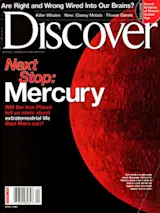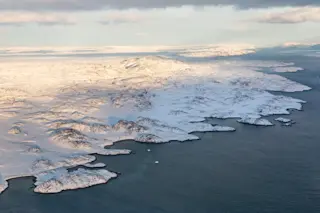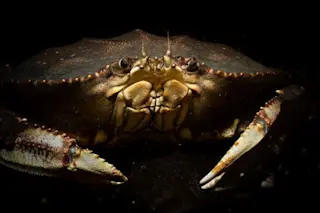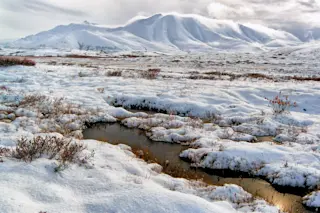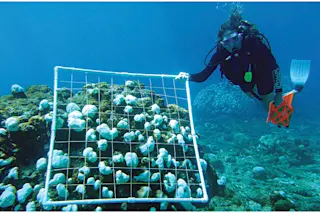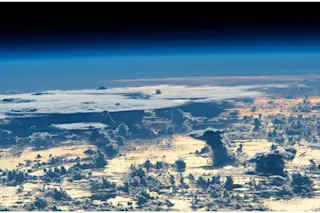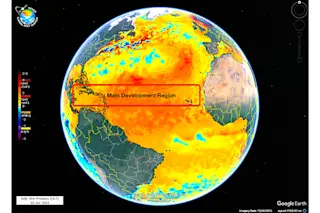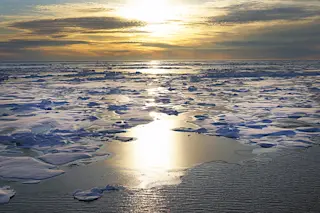The harbor seals in Hood Canal, a 60-mile-long fjord to the west of Puget Sound, seemed anxious. Some were quivering along the banks. A few squirmed out of the water and wiggled toward high ground, passing close to people onshore—surprising behavior that suggested something spooky in the waters below. Brian McLaughlin had never seen them behave that way. “I’m reluctant to anthropomorphize,” says the fish biologist for the Washington State Department of Fish and Wildlife, “but they looked really nervous.”
For good reason. Over several weeks, about half the harbor seal population in the canal—700 salmon-fattened mammals—had become lunch. During the winter of 2003, 11 killer whales—orcas—did something marine mammal scientists say is without precedent. A newly formed pack of them swam into this harbor haven and ate all seals, all the time for two months straight.
One of the killer whales, a supersize male dubbed T-14, was a well-known local. He had been captured in Puget Sound in 1976 as part of an operation to supply orcas to aquariums. After a public outcry, he had been released, but not before a temporary transmitter was attached to his dorsal fin, which created a pair of identifying scars. The others with T-14 were interlopers from the north. Scientists knew all 10 of them—a male and three female-led family groups of four, three, and two—from the waters off northern British Columbia and southeastern Alaska. They had not been seen before with T-14.
The eight-ton predators had become a gang, an aquatic Hells Angels that hunted cooperatively, skulking among the five main sites in the canal where seals haul themselves out of the water to rest. Every day, scientists calculated, each of the 11 killer whales may have eaten one or two seals.
Then at noon one Monday in March, the orcas simply swam under the floating bridge at the north end of Hood Canal and disappeared into Puget Sound. Now scientists are hoping they’ll come back. “Why these animals stayed together so long in Hood Canal is a mystery,” said John K. B. Ford, one of the world’s leading researchers on orca behavior and a marine mammal scientist at the Canadian government’s Pacific Biological Station on Vancouver Island. “Their stay is an unusual opportunity to look at predation and how it might affect populations of the marine mammals they eat.”
Killer whales—icons of the Pacific Northwest’s environmental movement—are behaving badly. The beasts that inspired Free Willy, the children’s movie about a lovable orca held by an evil marine-park owner, seem to have developed untoward dining habits in the last half century. Long known as highly skilled group hunters, cooperatively stalking fish and marine mammals from Alaska to Antarctica, from Argentina to Iceland, they appear to have nearly wiped out regional populations of ocean mammals in both the Northern and Southern hemispheres.
Specifically:
• In the Aleutian Islands off Alaska, killer whales may have decimated entire colonies of sea otters.
• In coastal Alaska, orcas are a prime suspect in the otherwise unexplained disappearance of 80 percent of Steller sea lions over the past three decades.
• In the Northern Pacific and the southern Bering Sea, killer whales have been linked to collapsing populations of fur seals and harbor seals.
• In Antarctica, they are the plausible cause of sharp declines of southern sea lions and southern elephant seals.
• Also in Antarctica, orcas may be a factor in a purported dramatic reduction of minke whales.
In short, some orcas appear to have stepped up their appetite for certain marine animals. The likely cause, some researchers believe, is whaling. According to a new theory of predation—published late last year in the Proceedings of the National Academy of Sciences (PNAS)—humans sharply reduced the orcas’ main source of food in the 1950s with the postwar explosion of industrial whaling. “When that happened, some killer whales, which had been preying on big whales, had to do other things to make a living,” says James Estes, a research scientist in Santa Cruz, California, for the U.S. Geological Survey and coauthor of the PNAS article. “When the number of prey was insufficient to satisfy them—they do eat a lot—they moved on to something else, and they did it in a sequential way.”
First the orcas turned to large mammals—elephant seals in the Southern Hemisphere, Steller sea lions in the Northern. When those populations thinned out, the theory goes, they moved on to smaller prey, such as harbor seals and sea otters. Thus far, the orcas’ strategy seems to be working, at least from their point of view. While populations of sea lions, seals, and sea otters have disappeared, orcas are doing rather well. Although there are no official counts, the number of killer whales is believed to be relatively stable, at 30,000 to 80,000 worldwide.
Not everyone accepts this theory. Several prominent marine mammal scientists, not to mention animal protection activists, strongly disagree with the notion that orcas have become species-destroying marauders. They say the evidence is thin and argue that the theory could be used as an excuse to avoid reducing coastal pollution, which threatens all marine mammals, including orcas. “It is the Greenpeace nightmare,” Trevor Branch, a doctoral candidate at the University of Washington’s School of Aquatic Fishery Sciences, wrote in a presentation he gave last year to marine mammal scientists in Santa Cruz. “Antarctic minke whales are the banner-waving symbol of the antiwhaling movement, but so is Free Willy. What do you do when one is decimating the other?”
Not all orcas are slaughtering sea mammals—at least not on North America’s West Coast, where killer whales have been studied closely by scientists. Researchers now classify those killer whales into three groups: “resident” orcas that feed exclusively on fish, “transient” orcas that usually eat marine mammals, and “offshore” orcas that are so mysterious no one knows what they eat. (Actually, all three types of orcas are dolphins—the largest members of the dolphin family.)
Resident orcas are the more predictable and, in many ways, more lovable. They live in large family-centered pods that tend to stay in one relatively confined area. These are the orcas that scientists have been able to study closely for generations, especially in waters off Washington State and British Columbia. They are the star attractions at the three SeaWorlds around the country. Resident females live about 50 years, males about 30 years, and it is not uncommon for members of a pod, usually headed by the oldest female, to live and fish together for several decades.
Far less is known about transients. It was only 25 years ago that scientists first understood that a different kind of orca existed. One reason the transients remained hidden for so long is that there are fewer of them. In the Aleutian archipelago, for example, where scientists estimate 3,888 killer whales were living in 1995, only about 7 percent, or 272 animals, were thought to be transients. “Transients are very sneaky, very quiet, and very difficult to keep track of,” says Ford. He is coauthor of the solidly researched popular book about the animals, Transients: Mammal-Hunting Killer Whales (University of British Columbia Press, 1999).
Transients and residents have next to nothing to do with each other. Transients observed in Puget Sound tend to slink away from big pods of residents. DNA studies show that the two groups have not interbred for thousands of years.
Genetics and territorial segregation have given residents and transients a slightly different physical appearance. The dorsal fin of a resident is usually rounded on top while the fin of a transient is pointed. The two groups also make different sounds. They “speak” dialects—in both cases a high-pitched screech—that are so distinct from each other that even harbor seals seem to know the difference. A study in 2002 showed that seals do not react to the recorded vocalizations of fish-eating orcas, but they do get jumpy when they hear transients. Perhaps for that reason, transients do not vocalize while hunting.
Unlike resident orcas, who stay with their mothers for life, postadolescent transients sometimes break away fairly quickly. As adults, they travel in small groups of two or three, frequently swapping travel mates and hunting together for brief periods of time. Ford does not like to use the term pod to describe a small group of transients. He thinks it implies a permanency and familial commitment that does not exist. Indeed, some marine mammal biologists have compared them to street gangs in urban areas.
For example, T-14, the big male who participated in the Hood Canal seal hunt, has an observed history of joining forces with other transients merely for an easier kill.
“When T-14 is with a gang, he will work with others, usually for an hour or two, to subdue and kill a sea lion,” said Ford. “These are flexible animals with a very dynamic social system.”
eeping track of transients is exceptionally difficult because they have a habit of disappearing for long periods of time. One killer whale was missing from the coast of British Columbia for 12 years, Ford said. He and other researchers have no idea where it went or what it ate while traveling. “There really are major gaps in our understanding of how these animals tick,” Ford said. “Out in the open ocean, we don’t even know for sure what they eat.”
What has been periodically witnessed is how transients hunt together, like a pack of wolves or a pride of lions. The size of the hunting pack depends, in large measure, on the size and ferocity of what’s available to hunt and how much cooperation is needed to kill it. Groups of three or four transients typically go after a young harbor seal, whacking it senseless with their tails, then sharing it. Five or six transients usually hunt Steller sea lions, which are big, mean, and have huge canine teeth to fight back. These hunts can take up to two hours, with transients ramming the sea lion or striking it with their tails until it is weakened enough to be drowned.
Much larger gangs of transients come together to attack giant whales in the open ocean. The orcas surround and harass a potential victim much like a motorcycle gang might group around a limousine on a lonely stretch of highway. In the late 1970s, observers on a SeaWorld research boat off the tip of Baja California saw about 30 transients come in from all angles to attack a 60-foot blue whale. Two pulled up in front, two stayed behind, and others surrounded it from both sides and from below. Some jumped onto its back, in what observers speculated was an attempt to drown the whale. They took turns biting off chunks of its blubber. Perhaps because they were full or because they got tired, they abandoned the blue whale after about five hours.
Transients may have started having trouble finding food five decades ago. By the time highly mechanized whaling reached its peak in the early 1950s, most whale species—including humpback, fin, and sperm—had been reduced to a fraction of their historical numbers. In the North Pacific and southern Bering Sea prior to whaling, a conservative estimate of whale biomass was about 30 million tons. When the International Whaling Commission imposed a moratorium on whaling in 1985, only 3 million tons of living whale remained in the North Pacific and Bering Sea. “Commercial whaling in the North Pacific Ocean,” the PNAS paper says, “set off one of the longest and most complex ecological chain reactions ever described.”
Starting in the 1960s and 1970s, killer whales seem to have begun eating increasing numbers of harbor seals. They then moved to fur seals and, by the 1980s, were attacking sea lions. Scientists say the orcas probably preferred harbor seals and sea lions because of the high volume of their fat and the relative ease of killing them. Steller sea lions are bigger—males weigh up to 2,200 pounds—but much more work to kill. Even so, the orcas apparently moved in on them as well.
Last year a study by the National Academy of Sciences reported that in the last three decades the Steller sea lion population dropped from several hundred thousand to about 30,000—so few that they are now listed as threatened under the Endangered Species Act. Robert Paine, professor emeritus in the University of Washington’s biology department and chairman of the National Academy of Sciences study, has called for more research. But he has little doubt about blame. “The obvious cause is that sea lions are being eaten by killer whales,” he says. “They are a nice, big, juicy meal.”
When the supply of sea lions and harbor seals ran low, orcas apparently turned to the next ready meal—sea otters. “My bad joke about sea otters is that they might as well be dental floss,” says Paine. “They can’t provide much nutrition.”
For an orca, a sea otter is a very small, very hairy hors d’oeuvre. Killer whales are about 26 feet long and eat 3 to 4 percent of their body weight a day. Alaskan sea otters weigh between 35 and 90 pounds—and that includes lots of hair. (Otters have the densest fur of any animal.) Killer whales need to eat at least seven otters a day to meet minimal nutritional needs, according to calculations by researchers at the University of California at Santa Cruz.
Hairy or not, the hors d’oeuvres disappeared. In the 1990s, most of the 50,000 otters in the central and western Aleutians vanished, after a century-long recovery from overhunting. When Estes documented their disappearance, he slowly came to the conclusion that killer whales were to blame.
Estes determined that it wouldn’t take many orcas to do the job. Since one killer whale can hunt and kill as many as 1,825 sea otters a year, he estimates, as few as four killer whales on an all-otter diet could have eaten more than 40,000 in western Alaskan waters since 1990.
Earlier research in the Southern Hemisphere, where industrial whaling was most relentless, paints a similar picture of ecological disruption. Estes estimates that before industrial whaling, the amount of food that orcas could find by eating whales was about 60 times greater than what was available from the combined numbers of seals, sea lions, and sea otters. The transients could have been driven by hunger to make up for the smaller, less nutritionally satisfying sea mammals by eating many more of them.
First to go in the Southern Hemisphere were elephant seals, a reasonable substitute for great whales, given their girth. Starting in the 1970s, says Branch, the number of southern elephant seals around certain Antarctic islands plummeted from 450,000 to 280,000 before stabilizing in the 1980s.
It is possible that the theory of killer whales laying sequential waste to marine mammals worldwide is simply bunk. There are a number of eminent marine mammal scientists who either don’t buy it at all or say there is too little data to support the sweeping claims. “I haven’t been impressed by their knowledge and understanding of killer whale biology,” said Craig Matkin, a marine mammal biologist from Homer, Alaska, who has been studying orcas for 20 years.
In addition, a global theory of killer whale predation depends on educated—and far-flung—guesses of how many marine mammals may have been killed by orcas over a set period of time. Those guesses could be wrong. Branch had estimated early last year that orcas may have been a factor in the disappearance of half the minke whales in the Southern Hemisphere. He later said that the minke whale population estimate was mistaken and noted that there was little compelling evidence showing that killer whales were significantly reducing minke whale numbers in that region.
And yet evidence of killer whales ravaging populations of seals, sea lions, and especially sea otters in the Northern Hemisphere is regarded by many scientists as all but unassailable.
What does seem clear is that scientific controversy regarding the eating habits of killer whales is not going to fade away. Matkin and other biologists say there is no compelling historical evidence that large numbers of killer whales were ever dependent on the great whales wiped out by industrial whaling. Such evidence is unlikely to be found. Matkin said he also worries that blaming killer whales for recent sharp declines in marine mammals will give politicians and bureaucrats an excuse not to protect coastal water quality and habitat.
Orca Snack Bar
Killer whales have such a voracious appetite that sea mammals are not safe — even on land. Orcas are known for throwing themselves onto beaches, sandbars, or ice floes to grab victims, or for smashing into floating ice to knock potential prey into the water.
If nothing else, they are opportunistic when it comes to food. They readily change their diets based on what is available. Scientists have discovered the remains of many unexpected animals—including sea turtles, penguins, polar bears, and moose—inside the stomachs of orcas. In recent years killer whales have been observed eating a wide variety of sea mammals, such as dolphins, porpoises, gray whales, and these animals:
Elephant Seal: 2,000–6,000 pounds, 7–16 feet long
Sea Otter: 35–90 pounds, 3–5 feet long
Harbor Seal: 100–375 pounds, 4–6 1/2 feet long
Steller Sea Lion: 550–2,200 pounds, 8–10 feet long
Minke Whale: 5–10 tons, 15–40 feet long
Animal protection groups have their own problems with the theory. Naomi Rose, a marine mammal scientist for the Humane Society of the United States, complains that orcas are easy and cheap scapegoats for problems caused by people. In an op-ed piece in the Seattle Post-Intelligencer, Rose says overfishing and pollution are more important and more likely causes of population decline among seals and sea otters in the North Pacific than are orcas. In another article, she argues that “inflammatory articles may lead someone to propose an orca culling program to save the Alaskan ecosystem.”
So far, that seems unlikely. No one has proposed that killer whales be executed for inappropriate dining habits. And federal law protects all marine mammals. Experts say the only thing humans should do about changes in orca behavior is pay attention. “You don’t do anything about it,” said Lance Barrett-Lennard, senior marine mammal research scientist at the Vancouver Aquarium Marine Science Center. “You say God is in his heaven and you breathe a big sigh of relief. If we have learned anything, it is that stability doesn’t exist in these ecosystems.”
For the cascade theory of killer whale predation to stand up, there needs to be evidence that transient orcas, given the chance, would eat a whole lot of whale. Some of that evidence is being gathered off the coast of California, where recovering populations of humpback, gray, and blue whales show telltale signs of attacks by killer whales. Close to a third of the humpbacks—the fifth largest animal in the world, growing to the weight equivalent of 10 elephants—are scarred by what appear to be the teeth of transient orcas. The vulnerable calves of migrating gray whales are known to be a favorite of the transients near California, and the carcasses of minke whales have been found in the same area.
“A lot of the attacks are unsuccessful, but our research indicates that killer whales almost always test humpbacks,” says John Calambokidis, a research biologist at the Cascadia Research Collective, which does marine mammal studies in Puget Sound, as well as in the eastern and North Pacific.
With so little known about the behavior and diet of transient killer whales, Calambokidis cautions that any theory about what they eat and why has a high likelihood of being nonsense. It is not known, for example, whether transients are content to rip blubber off whales for supper or whether they frequently succeed in making kills of adult whales. “It almost sounds like killer whales are being blamed for the decline of every marine mammal out there,” he says. “I worry sometimes that we could come up with a good idea that explains one thing and try to explain everything with it.”
Even those who blame transients for the sequential slaughter of seals, sea lions, and sea otters in Alaska concede that court-of-law proof of the killings is impossible to obtain. “My gut feeling is that it is right,” says Estes, who champions the predation theory. But “it could very well be wrong.” The test, he says, will be the future. If the great whales recover, orcas might stop eating smaller marine mammals and return to larger, more satisfying meals.
Such a recovery in the whale population is under way among some species, but it still has a very long way to go. The world’s oceans contain only about 14 percent of the stock that was there before the era of industrial whaling.
Estes says that some of the opposition to his theory about marine mammal predation derives less from the behavior of killer whales than from the behavior—and beliefs—of human beings. “There are people who are so invested in this species that they don’t like someone else coming in and telling them something different,” he says.
In the case of the slaughtered harbor seals of Hood Canal, transient killer whales may have done a good deed for the environment. Local fishermen believe there are probably too many harbor seals in Puget Sound. And in a very visible way, the harbor seals were showing how human interference in marine ecosystems could have unintended consequences. The seals have been feasting in recent years on summer chum salmon, a threatened species that American taxpayers are spending millions of dollars to save. Since the Marine Mammal Protection Act covers seals, there was little that could be done to safeguard these salmon—until the 11 transients showed up for their big meal.
The behavior of the Hood Canal 11 is also a tantalizing case study in the killing and learning capacity of transients. Estes calls the hunt the “first concrete and well-chronicled example of killer whales coming in and doing a significant amount of damage to a population.” He adds, “With all the other cases, there is some uncertainty as to whether the population declines were really caused by killer whales.”
Scientists who watched the transients dine in Hood Canal more than a year ago are eagerly waiting to see if they’ll return from Alaska and British Columbia for a second course. “Have they developed this memory of a good place to eat on the West Coast?” asks Steven Jeffries, a research scientist for the Washington State Department of Fish and Wildlife. He saw harbor seals quivering on the canal’s banks during the 2003 winter feeding frenzy. If the transients do come back, the quivering seals of Hood Canal could become a tourist attraction, assuming they get out of the water in time. But so far it is a waiting game. As of Groundhog Day, the transients had not returned.


